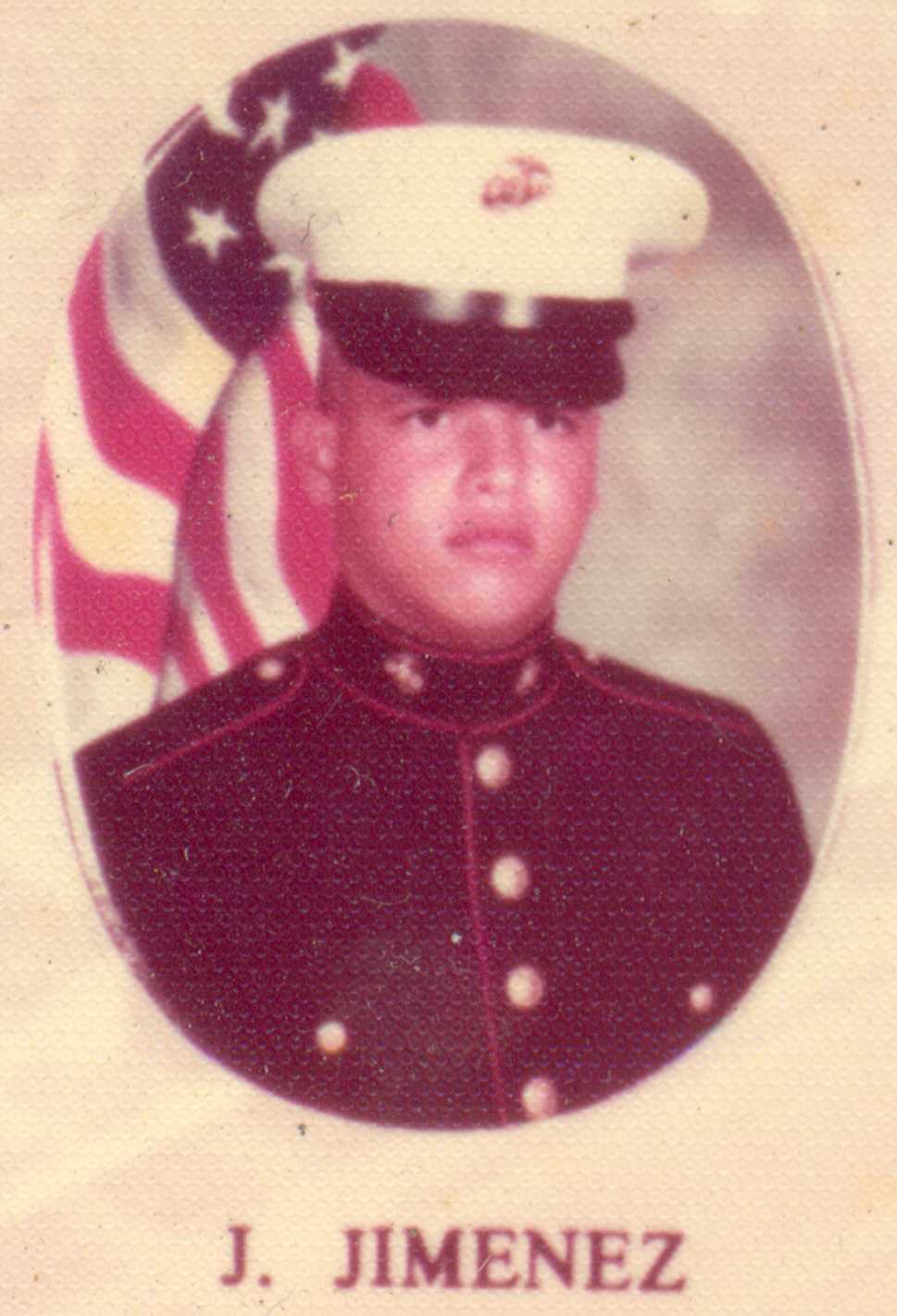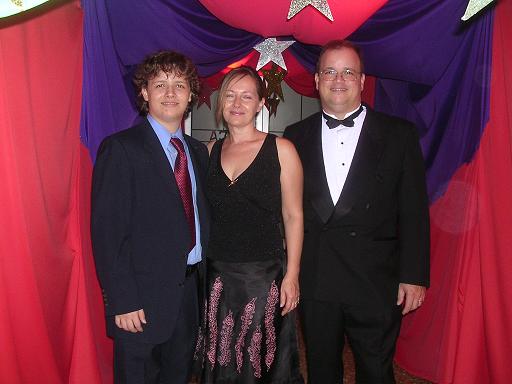

(Marine Corps pic circa 1978, family picture circa 2005 or so...)
Good question. Who am I?
(…the one on the right, on the left is my son Gustavo, and in the middle it's my wife Liliana…)
I'm Juan Jiménez, and I live in San Juan, Puerto Rico, an island in the Caribbean... third island down from Miami (first is Cuba, then the Dominican Republic and Haiti, then Puerto Rico). The island has been an unincorporated territory of the United States since 1898, when Spain ceded it to the US as reparations for the Spanish-American War. Everyone born in Puerto Rico is a US citizen by birth, and more Puerto Ricans per capita have served in the US military and various wars than any territory or state of the union.
I took my first flight lesson from "Comandante" Patrick Jordan at Universal Aviation in San Juan, Puerto Rico, a flight school that used to be located in what is now a number of private hangars at Isla Grande Airport. Even the name of the airport has changed, it's now Fernando Luis Ribas Dominicci Airport.
That was back in 1974, and things have changed quite a bit since then. Whether or not General Aviation in Puerto Rico has changed for the better or for the worse is a matter of opinion. I think it's declined quite a bit, and it's sad to see just how much it has deteriorated. Nowadays you almost have to be rich to be able to fly and own your own little airplane. But that's another story for another day.
Until January of 2004 I was a a Staff Master Trainer and Consultant for a very successful software company in California. I was a field employee, which meant that I worked out of my home office and travelled to customer sites to provide training or consulting as needed. Most of the time I stayed at home and wrote courseware for the company products, which range from language compilers to enterprise-level design solutions and embedded SQL database engines. They fired me when I moved to Puerto Rico on the excuse that they did not want to have any kind of presence in Puerto Rico. However, I have an email from a senior manager who was subsequently fired, stating that he talked to the head of HR and was told the company was not opposed to my moving to Puerto Rico, but they didn't know how to pay me and no one wanted to take up the challenge finding out. Never mind that ADP, their payroll processor, pays 35,000+ people in Puerto Rico. Get my drift?
I now work as a Senior Partner for a prestigious firm that provides management consulting services to corporations and non-profit organizations with significant investments in information technology. I am certified to the highest level of IT Service Management (Service Manager, or ITIL "Master"), a professional training program commonly described as "getting Master's degree in three months." Obtaining this certification requires 320 hours of study, 800 pages of reading, two week-long class sessions and two three-hour handwritten essay tests. For more information on the ITSM Service Manager certification, click here.
I've been in the computer industry for some 30 years now, with about half of that as an independent consultant and the other half as an employee. I was born in Río Piedras, Puerto Rico and grew up in the neighborhood known as Miramar, where I live these days. I'm married to Liliana, to a beautiful artist from Argentina, and have one son, Gustavo, 14 years old going on 20. He's half Puerto Rican, a quarter Italian and a quarter Polish. What a genetic mix, eh? He plays the piano and electric guitar extremely well, and is very much into Japanese animation and cartoons. I have four sisters and one brother; one sister is married to a native of India, another is married to an Iranian-born engineer, another is married to an Italian chef, the fourth sister is single and my brother is married to a Puerto Rican. Makes for some very interesting Christmas dinners!
I came back to general aviation in the fall of 1996, after seeing an ad for an upcoming private pilot ground school at Hill Aviation -- which I would highly recommend except for the fact that the company was sold in early 1998. On February 27, 1997, designated examiner René Cardona (now retired) thought highly enough of my flight skills to issue me a Private Pilot license, Airplane Single-Engine Land. Since then I have also obtained my high performance aircraft, complex aircraft and taildragger aircraft endorsements at Attitude Aviation in Livermore, California (Rich Perkins' flight school and FBO), and on Aug 16, 1998 I obtained my Multi-Engine Land rating on a 1972 Cessna 310Q at RockAir Aviation, located at Front Range Airport, Watkins, Colorado (FTG).. In April of 1998 I passed my instrument rating test with a score of 90 after many long nights with the Mentor multimedia instrument rating course and the Jeppessen test review software. I am hoping to finish by the end of 1998, but I still need more cross-country hours as well as the rest of the instrument training hours.
Why is Juan building an experimental aircraft? Is he crazy?
The second question is easy to answer. Aren't we all a bit crazy? The only difference between me and you (assuming you're not also building one of these) is that I have a harder time controlling my "craziness."
The reason I'm building the aircraft is that I don't want to grow old wondering what it would have been like if I had tried to make my childhood dreams come true. The very earliest memories I can recall are of flight, as a 2-year-old watching a Coast Guard helicopter trying to land in an open field in what is now Summit Hills. The helicopter could not land because I was too close to it. In my diapers, no less. My mom doesn't believe me, but its true.
The other big reason for doing this is to show that it can be done, and perhaps inspire others to pursue their dreams as well. Exhibiting the aircraft after it is completed would also show the children what they can do if they set their minds to it, that there are no limits to what Puertoricans can do, and that they should be proud of that. There are other experimental aircraft builders and owners in Puerto Rico, building everything from SeaRey amphibs to Cozy high performance canard composites, and everything in between. I'm sure they would also love to show off the fruits of their labor to all Puertoricans.
Why a BD-5?
When I was fifteen years old I made a trip to the Isla Verde airport (SJU/TJSJ, LMM International) and happened to run into a BD-5 that someone had partially completed and was trying to sell. I had seen the article in Popular Mechanics, but had never seen the aircraft and did not expect to find one in Puerto Rico. What a surprise! I fell in love with the little-bitty bird. Nowadays kits in various stages of completion (and completeness) are available from under $1000 to upwards of $250,000, depending on engine configuration.
The BD-5, contrary to what some have said in the past, is a stable aircraft. The design is good, but the aircraft, as with any other high performance bird, demands greater skills than what the garden variety weekend Cessna 152 jockey can give. Its controls are sensitive, and you have to keep a sharp eye on the airspeed, particularly on approach and landing. In short, a fun airplane. Some people say that the BD-5 is a widowmaker, that it crashes a lot and that it is unsafe. A cursory analysis of the NTSB reports shows that the majority of BD-5 accidents have been, for the most part, due to pilot or builder "mistakes" (to put it mildly), and that they are not that different from the kinds of problems other homebuilt aircraft have had. Not paying attention to weight and balance as well as CG, improper construction, "too eager to fly," not maintaining currency while building and no experience in high performance aircraft are the most common causes for BD-5 accidents. Also, the original BD-5 "A" model had a very short wingspan. This in turn resulted in high wing loading, and an aircraft that was almost impossible to handle for everyone except for highly experienced pilots. Even so, it was hard to fly. Nowadays the "A" wing is not recommended, and is used by very few people, mostly for the purpose of setting speed records in the 300kg-or-under, reciprocating engine category. Recommended training for a potential BD-5 owner should include time on high performance aircraft, preferably the Grumman AA-1 Yankee trainer, or perhaps the Cessna 310, whose V speeds are very close to those of the BD-5.